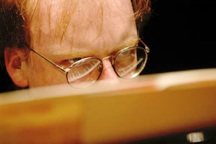
2013.02.01
“Contextual Piano”

Hybrid recitals in which music form the 20th and 21st centuries is mixed with “classical” pieces have gained more and more popularity, especially during the 1990s and 2000s, as they combine and contextualize pieces from various periods, genres and styles. The proposal by Patrícia Sucena de Almeida and Ian Pace, duo, which has already realized together various projects, puts emphasis on the historical contextualization of the piano recital, so to say, of its two aspects. On the one hand the first part of the concert, comes from the line traced by Franz Liszt (“Fantasy and Fugue on the Theme B-A-C-H”), whose virtuosity and experimentalism found, during the 20th century, their reflection in the theatrical interventions by Mauricio Kagel (“MM51”), Dieter Schnebel (“espressivo”) or Frederic Rzewski (“De Profundis”). All of them tend to deconstruct the act of performance. On the other hand a more modernist line was traced after the interval. It begun with the “impressionistic” approach of “6 Épigraphes Antiques” by Claude Debussy, passing through the concentration of “Extensions 3” by Morton Feldman, the radical intimacy of “…sofferte onde serene…” by Luigi Nono and finishing the concert with the premiere performance of the new piece by Patrícia Sucena de Almeida, “reditus ad vitam”.
Multidisciplinary projects, which include the inter-reaction between various arts, have already become Patrícia Sucena de Almeida’s “trademark”. Simultaneously she is developing a Postdoctoral project at the University of Aveiro implying a study, analysis and development of New Concepts of Interaction between Various Arts with the Musical Language and its Application in Compositional and Multidisciplinary Models. “Reditus ad vitam” follows this path as it includes a poem by Russel Edson, “The Marionettes of Distant Masters” (diffused at the beginning as a prologue to the piece), and the choreography by Teresa Gouveia with the intervention of two dancers. This work constitutes a 21st century response to the other “historical” pieces of the concert, aiming to synthesize and perhaps to develop not only their musical aspects but also the ones related to combining various artistic languages. Here, the music, which through its complexity either rhythmical or dynamic seems to mimic a “butterfly dance”, as well as the text, the movement, the light, lie within the creation or influence of the composer. The surreal, grotesque and “light “ character of the poem seems to influence the music, which gives impulse and nourishes the choreography, “turning on and off” through certain sound gestures the movements of the dancers.
To fantasize, meditate and lucubrate on this game of interactions, text-music, music-choreography and text-choreography, is a pleasant mental activity, however, the aesthetical perception in this case does not surpass the limits of a speculation. Apart form intellectual pleasure, music should also provoke emotional reactions, and it is precisely this element which lacked in listening to (and seeing) “reditus ad vitam”.
The pair constituted of Patrícia Sucena Almeida, with her multidisciplinary interest, and by Ian Pace, versatile pianist whose repertoire privileges new music, but who at the same time relies on the logic of hybrid programmes, without any doubt serves to construct a concert/spectacle, which appeals to a more diversified public, embracing so to speak, music for all tastes. Perhaps this is the reason that the concert had an excellent presence of the public, which certainly recognized in the programme’s strategy the educational value meticulously outlined by Patrícia Sucena de Almeida. Nevertheless, concerning the presented programme, as well as the performance, I would like to stress some aspects, which made this concert/spectacle less appellative than its aspiration.
Regarding the already mentioned versatility of Ian Pace, if on the one hand it is without any doubt a positive factor, on the other it brought out the imperfections, which have to do with an underlying interpretative superficiality. It derives directly form the performance of a too diversified repertoire, precluding, in my opinion, the adequate attention paid to the multiplicity of interpretative nuances. It is not by coincidence that today more and more specialization exists in what concerns the performance of music form various periods – early, classical, romantic or contemporary.
The second aspect, which I would like to emphasize, is related to the form of the concert. It is developed in an either multidisciplinary or modernist line, presenting all of the works in a “musicological” and “historical” context – the logic is to expose the evolution of the musical language of the piano repertoire. This goal is lost, to my mind, in the recital’s density and duration, which certainly did not take into account the perceptive capacities of the listeners; it lasted approximately 2h45, whereas having been announced as 1h30.
The concert, “From Liszt’s Pianistic Virtuosity to the Multi(n)discipline of the 21st Century”, surely constitutes an interesting proposal of conceiving a piano recital. However it deserves to be reworked in what concerns the details of execution and programming – less works would probably mean a more cautious interpretation. And regarding the Portuguese premiere of Patrícia Sucena de Almeida’s new work, we remain with the expectation that her investigation on the interactions between various artistic forms will result in a future work, whose impact and beauty will surprise us and stir our emotions.


